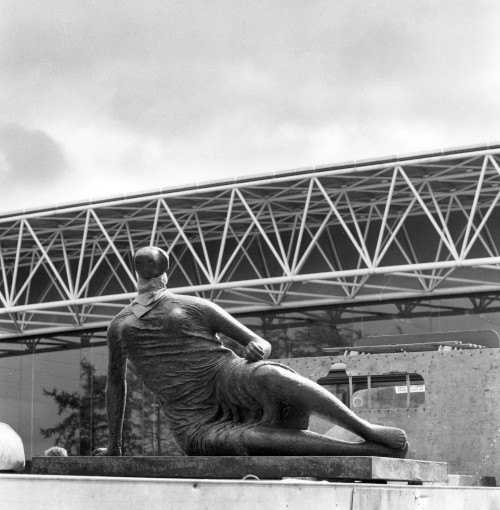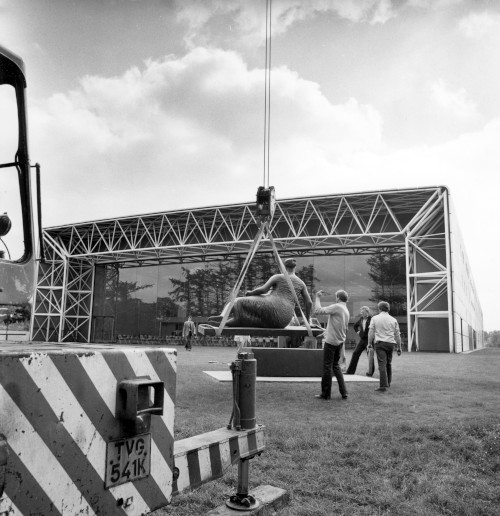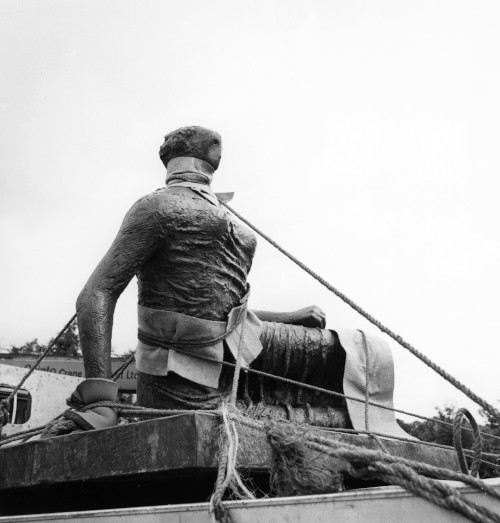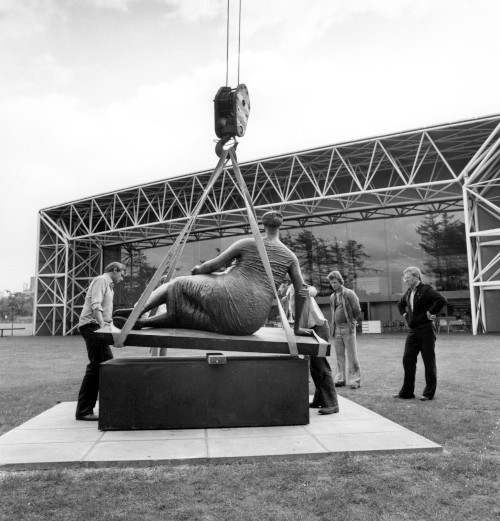Draped Reclining Woman
Henry Moore
Life Story
Drapery appeared in Moore’s oeuvre during the Second World War, first in his shelter drawings and soon afterwards in a series of Madonna and Child maquettes in 1942. Moore did not return to drapery in a consistent way until almost a decade later, until he viewed classical sculpture during his initial visit to Greece in 1951.
Although examples of draped figures do exist in Moore’s sculpture before the 1950s, those from the 1940s – such as Madonna and Child (1943–4) and Memorial Figure (1945–1946) – are starkly different in style. As opposed to ‘the classical’, David Sylvester suggested, the earlier works evoke ‘the gothic’. [1] Despite the clear influence of seeing sculptures from antiquity in their country of origin in Greece, this difference in style was also due to Moore’s changing techniques. His earlier works in stone saw large, smooth areas of drapery, with only a handful of folds, due to the restrictions in carving detail in stone. Later, Moore worked in clay maquettes and then plaster models to be cast into bronze. The plaster is first applied to the armature soaked into scrim (a fabric), before more layers of wet plaster are added. When this was dry, Moore continued to work into the surface with tools to create the desired texture. This technique lends itself to portraying detail, which is then faithfully replicated in the bronze cast.
The finer drapery, with intricate creases and crinkles, resembles much more closely that of classical sculpture. In his book Henry Moore at the British Museum, Moore described a sculpture in this style: ‘The drapery here is so sensitively carved that it gives the impression of light, flimsy material, wet with spray, being blown against the body by the wind.’ [2] He goes on to explain, ‘It shows how drapery can reveal the form more effectively than if the figure were nude because it can emphasise the prominent parts of the body, and falls slackly in the hollows.’ [3] He maximises on this feature in Draped Reclining Woman, as the fabric seems to be pulled tight over her breasts and falls in large folds between her slightly parted legs.
Moore regularly viewed the Parthenon Marbles at the British Museum. Even in the static marble, and sometimes in reclining poses, these ancient Greek sculptures seem to have movement and energy, which is emphasised by the drapery. The gap between the legs in Draped Reclining Woman similarly suggests imagined muscles at work, as if the figure is about to rise, pushing herself up on her supporting arm. This arm seems slender compared to the bulky body it holds, and the head is also slight. In fact, the proportions of this figure seem particularly disjointed compared to many of Moore’s other works. The detail in the drapery contrasts with a relatively simple head and face. The emphasis is on the torso and legs, and the drapery that is utilised to pronounce them. In a further nod to the classical, the maquette for this figure was damaged, leaving the torso without head, arms or legs. Moore had the resulting torso cast as a work in its own right, which became Fragment Figure (1957).
Tania Moore, September 2020
[1] David Sylvester, Henry Moore, (ex cat) (London: Tate, 1968), p.109.
[2] Henry Moore, Henry Moore at the British Museum, (London: British Museum Publications, 1982), p.62.
[3] Ibid.
In 1942 Lilliput observed that the first time Henry Moore had attempted drapery was in depicting civilians huddled in blankets in the London Underground: ‘The clothes of the shelterers gave him a new problem’. It was from these studies that Moore developed his enduring motif of the draped reclining woman. The image re-emerged after he visited Greece in 1951 where he was inspired by the drapery on classical sculpture.
Exhibitions
'Henry Moore at Dulwich Picture Gallery', Dulwich Picture Gallery, London, 12/5/2004 - 12/9/2004
'Bill Brandt | Henry Moore', Sainsbury Centre, UK, 3/12/2020 - 11/4/2021
Further Reading
Steven Hooper (ed.), Robert and Lisa Sainsbury Collection, volume 1 (Norwich: University of East Anglia, 1997)
Ann Garrould, Anita Feldman Bennett and Ian Dejardin, Henry Moore at Dulwich Picture Gallery (London: Scala Publishers, 2004)
Tania Moore, Henry Moore: Friendships and Legacies (Norwich: Sainsbury Centre, 2020)
Provenance
Purchased by Robert and Lisa Sainsbury from the artist in 1960.
Donated to the Sainsbury Centre, University of East Anglia in 1973 as part of the original gift.
On display
Title/Description: Draped Reclining Woman
Artist/Maker: Henry Moore
Born: 1957 - 1958
Object Type: Outdoor sculpture, Sculpture
Materials: Bronze
Measurements: h. 1450 x w. 2215 x d. 1115 mm
Inscription: Moore 4/6 H.NOACK BERLIN
Accession Number: 86
Historic Period: 20th century
Production Place: Britain, England, Europe
Copyright: © Reproduced by permission of the Henry Moore Foundation
Credit Line: Donated by Robert and Lisa Sainsbury, 1973
















